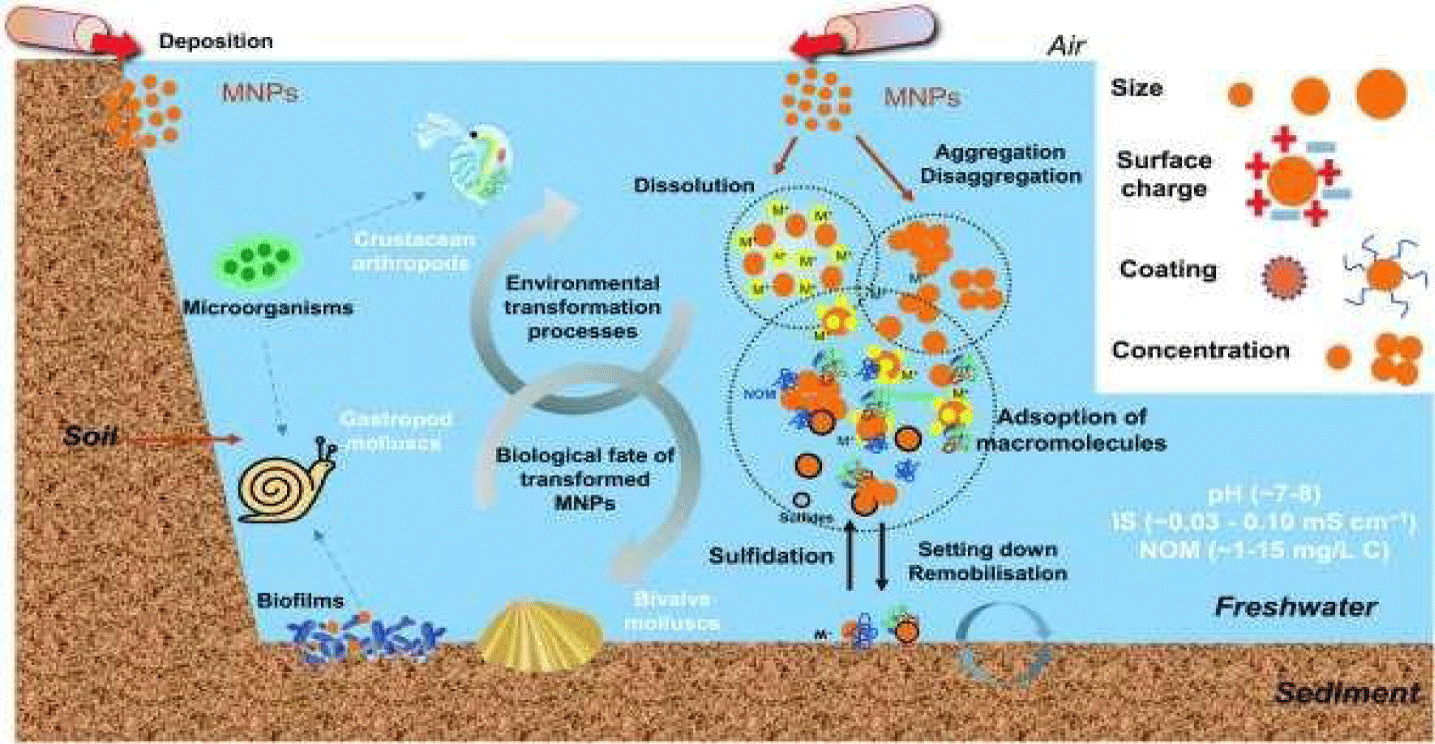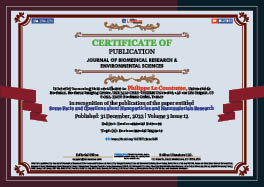Environmental Sciences . 2022 December 31;3(12):1562-1564. doi: 10.37871/jbres1635.
Some Facts and Questions about Nanoparticles and Nanomaterials Research
Philippe Le Coustumer1* and Weil Liu2
2Département F-A. Forel des sciences de l'environnement et de l'eau (DEFSE). Université de Genève 66 boulevard Carl-Vogt 1211, Genève 4, Switzerland
In 2014, the French National Agency for Food, Environmental and Occupational Health Safety (Agence nationale de sécurité sanitaire de l'alimentation de l'environnement et du travail) in its annual report wrote: "Nanomaterials can be absorbed by the body and migrate to other organs, leading to a potential systemic risk. The passage of nanomaterials through some biological barriers has been verified (e.g. alveolar-capillary barrier), while others need to be confirmed (passage through the placental (TiO2), hemato-testicular and hemato-encephalic barriers). The ability of nanomaterials to cross these barriers and their persistence in the body varies according to their physico-chemical characteristics, which influence not only their intrinsic properties but also their ability to interact with the environment in which they are found"[1].
It is reassuring to observe that the number of scientific articles (based on the keyword "nanomaterial" on PubMed) is increasing, with one publication in 1986, to less than 100 until 2000 and more than 1000 since the 2010s [2]. But what are the scientific issues behind this mobilization of the research community? If we look in detail the evolution of public budgets devoted to nanotechnologies (supposed to be one of the solutions will enable us to meet the challenges of climate, energy, food and health) we can see that the amounts allocated are substantial. But those earmarked for health and environmental consequences are symbolic. In 2003 in the USA, the budget dedicated to the study of environmental impacts was $200,000 out of a global budget for nanotechnologies of $700 million. In 2013, the US government allocated a budget of $1.3 billion to the National Nanotechnology Initiative [3], of which $105 million was allocated to the "Nano-Environmental, Health and Safety" sub-programme, i.e. almost 10%. There are also North American agencies in charge of health, such as the National Institute for Occupational Safety and Health, which saw its budget double in 2014 (3 to 7%, i.e. US$120 million). Compared to the global market for manufactured nanoparticles estimated at several trillion dollars per year in 2016 and a projected annual growth rate of more than 18% until 2021 [4], we are still far from a priority area about their fate and interactions with living organisms? In 2021, the National Science and Technology Council in the USA presented its approach [5] in which societal impacts on health and ecosystems are never mentioned. The priorities remain production, R&D and promotion (education and training). Health & environment aspects are the poor member of public and private programs, while due to their remarkable properties their studies are complex and leave the question of their harmlessness open. In 2012, the ISO/TR 13014:2012 standard on the physico-chemical characterization of nano-objects was published. This norm describes the relevant physico-chemical properties of nano-objects necessary for their physico-chemical characterization: particle size / particle size distribution, aggregation/agglomeration state, shape, specific surface area, chemical composition, purity and impurity level; surface chemistry, surface charge, solubility and dispersibility. This standard does not take into account biological aspects. Can we deduce from this that this type of material has no impact on living organisms? Can they change under different biophysical and chemical factors? Part of the scientific community is mobilized to specify the impact of nanomaterials on living organisms at different scales. The conceptual scheme proposed by Wang & Liu [6] allows a better understanding of the complex relationships and essential factors controlling their fate in a natural ecosystem. The authors show the influence of physico-chemical parameters on the mechanisms at play in a natural system combining organisms, freshwater and soils and sediments (Figure 1).
While some authors mention the holistic approach to identify the mechanisms at different scales of their fate in different natural compartments (water and soil) [7], the biological dimension, genotoxicity and "omics" approaches (genomics, proteomics, transcriptomics, metabolomics, lipidomics) are poorly mentioned [8]. Works on the biological responses (i.e. oxidative stress, modification of photosynthesis, metabolism) and onto the consequences from a genetic point of view (transcriptomics and proteomics) are regularly published [9-12]. Indeed, concentrations, at which biological modifications due to additive, cocktail or synergistic and antagonistic effects appear at levels much lower than those mentioned by the manufacturers', users' or mandatory tests (REACH regulation in Europe for example [13]). In conclusion, transdisciplinary approaches, combining crystallography, biology, ecotoxicology and physical chemistry, make it possible to study the interactions between materials and living organisms. It is fundamental to determine thresholds or doses according to chronic, one-off or accidental exposure by tests close to natural conditions. The socio-economic dimension (ethics, acceptability threshold, tolerance, benefit-risk principle), governance (national and transnational policy, regulation, norms) and the training-information aspect (influence of social networks, fake-news, professional training and education) are just as important and cannot be neglected [14]. Only a global transdisciplinary approach shared by stakeholders and interested parties will support a friendly sustainable development of one of our more revolutionary innovation because it impacts our daily life and environment.
References
- ANSES. Évaluation des risques liés aux nanomatériaux Enjeux et mise à jour des connaissances. Avis de l’Anses Rapport d’expertise collective. 2014.
- Biswas P, Wu CY. Nanoparticles and the environment. J Air Waste Manag Assoc. 2005 Jun;55(6):708-46. doi: 10.1080/10473289.2005.10464656. PMID: 16022411.
- NNI Supplement to the President's 2013 Budget. February 16, 2012.
- McWilliams A. The Maturing Nanotechnology Market: Products and Applications (NAN031G) 2016.
- National Sciences and Technology Council, Subcommittee on Nanoscale Sciences Engineering and Technology Committee on Technology. National Nanotechnology Initiative Strategic Plan. 2021;44.
- Wang T, Liu W. Transformation, bioavailability and toxicity of metal nanoparticles on freshwaters invertebrates. Environmental Sciences Nano. 2022;9;2237.
- Le Coustumer P, et al. Holistic Strategy to Study Nanoparticles and Metallic Trace Elements in Surface Waters. International Journal of Environmental Science. Prof Siavash Sohrab. 2017.
- Prat Odette, Degli Esposti, Davide. New Challenges: Omics Technologies in Ecotoxicology. 2019.
- Mocan T, Clichici S, Agoşton-Coldea L, Mocan L, Simon S, Ilie IR, Biriş AR, Mureşan A. Implications of oxidative stress mechanisms in toxicity of nanoparticles (review). Acta Physiol Hung. 2010 Sep;97(3):247-55. doi: 10.1556/APhysiol.97.2010.3.1. PMID: 20843763.
- Benameur L, Auffan M, Cassien M, Liu W, Culcasi M, Rahmouni H, Stocker P, Tassistro V, Bottero JY, Rose J, Botta A, Pietri S. DNA damage and oxidative stress induced by CeO2 nanoparticles in human dermal fibroblasts: Evidence of a clastogenic effect as a mechanism of genotoxicity. Nanotoxicology. 2015;9(6):696-705. doi: 10.3109/17435390.2014.968889. Epub 2014 Oct 17. PMID: 25325158.
- Kopac T. Protein corona, understanding the nanoparticle-protein interactions and future perspectives: A critical review. Int J Biol Macromol. 2021 Feb 1;169:290-301. doi: 10.1016/j.ijbiomac.2020.12.108. Epub 2020 Dec 21. PMID: 33340622.
- Yen Le TT, et al. Approaching a closer surrogate for the biologically effective dose with subcellular partitioning-based toxicokinetic models, Critical Reviews in Environmental Science and Technology. Taylor & Francis. 2022.
- European Chemicals Agency. https://echa.europa.eu/regulations/reach/understanding-reach.
- Schulte PA, Salamanca-Buentello F. Ethical and Scientific Issues of Nanotechnology in the Workplace. Environ Health Perspect. 2007 Jan;115(1):5-12.
Content Alerts
SignUp to our
Content alerts.
 This work is licensed under a Creative Commons Attribution 4.0 International License.
This work is licensed under a Creative Commons Attribution 4.0 International License.









